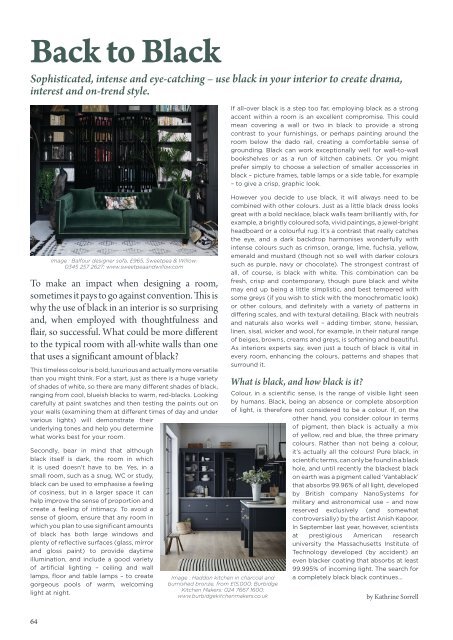I and A Mag Jan20
Telford Magazine
Telford Magazine
You also want an ePaper? Increase the reach of your titles
YUMPU automatically turns print PDFs into web optimized ePapers that Google loves.
Back to Black<br />
Sophisticated, intense <strong>and</strong> eye-catching – use black in your interior to create drama,<br />
interest <strong>and</strong> on-trend style.<br />
Image : Balfour designer sofa, £965, Sweetpea & Willow:<br />
0345 257 2627; www.sweetpea<strong>and</strong>willow.com<br />
To make an impact when designing a room,<br />
sometimes it pays to go against convention. This is<br />
why the use of black in an interior is so surprising<br />
<strong>and</strong>, when employed with thoughtfulness <strong>and</strong><br />
flair, so successful. What could be more different<br />
to the typical room with all-white walls than one<br />
that uses a significant amount of black?<br />
This timeless colour is bold, luxurious <strong>and</strong> actually more versatile<br />
than you might think. For a start, just as there is a huge variety<br />
of shades of white, so there are many different shades of black,<br />
ranging from cool, blueish blacks to warm, red-blacks. Looking<br />
carefully at paint swatches <strong>and</strong> then testing the paints out on<br />
your walls (examining them at different times of day <strong>and</strong> under<br />
various lights) will demonstrate their<br />
underlying tones <strong>and</strong> help you determine<br />
what works best for your room.<br />
Secondly, bear in mind that although<br />
black itself is dark, the room in which<br />
it is used doesn’t have to be. Yes, in a<br />
small room, such as a snug, WC or study,<br />
black can be used to emphasise a feeling<br />
of cosiness, but in a larger space it can<br />
help improve the sense of proportion <strong>and</strong><br />
create a feeling of intimacy. To avoid a<br />
sense of gloom, ensure that any room in<br />
which you plan to use significant amounts<br />
of black has both large windows <strong>and</strong><br />
plenty of reflective surfaces (glass, mirror<br />
<strong>and</strong> gloss paint) to provide daytime<br />
illumination, <strong>and</strong> include a good variety<br />
of artificial lighting – ceiling <strong>and</strong> wall<br />
lamps, floor <strong>and</strong> table lamps – to create<br />
gorgeous pools of warm, welcoming<br />
light at night.<br />
Image : Haddon kitchen in charcoal <strong>and</strong><br />
burnished bronze, from £15,000; Burbidge<br />
Kitchen Makers: 024 7667 1600;<br />
www.burbidgekitchenmakers.co.uk<br />
If all-over black is a step too far, employing black as a strong<br />
accent within a room is an excellent compromise. This could<br />
mean covering a wall or two in black to provide a strong<br />
contrast to your furnishings, or perhaps painting around the<br />
room below the dado rail, creating a comfortable sense of<br />
grounding. Black can work exceptionally well for wall-to-wall<br />
bookshelves or as a run of kitchen cabinets. Or you might<br />
prefer simply to choose a selection of smaller accessories in<br />
black – picture frames, table lamps or a side table, for example<br />
– to give a crisp, graphic look.<br />
However you decide to use black, it will always need to be<br />
combined with other colours. Just as a little black dress looks<br />
great with a bold necklace, black walls team brilliantly with, for<br />
example, a brightly coloured sofa, vivid paintings, a jewel-bright<br />
headboard or a colourful rug. It’s a contrast that really catches<br />
the eye, <strong>and</strong> a dark backdrop harmonises wonderfully with<br />
intense colours such as crimson, orange, lime, fuchsia, yellow,<br />
emerald <strong>and</strong> mustard (though not so well with darker colours<br />
such as purple, navy or chocolate). The strongest contrast of<br />
all, of course, is black with white. This combination can be<br />
fresh, crisp <strong>and</strong> contemporary, though pure black <strong>and</strong> white<br />
may end up being a little simplistic, <strong>and</strong> best tempered with<br />
some greys (if you wish to stick with the monochromatic look)<br />
or other colours, <strong>and</strong> definitely with a variety of patterns in<br />
differing scales, <strong>and</strong> with textural detailing. Black with neutrals<br />
<strong>and</strong> naturals also works well – adding timber, stone, hessian,<br />
linen, sisal, wicker <strong>and</strong> wool, for example, in their natural range<br />
of beiges, browns, creams <strong>and</strong> greys, is softening <strong>and</strong> beautiful.<br />
As interiors experts say, even just a touch of black is vital in<br />
every room, enhancing the colours, patterns <strong>and</strong> shapes that<br />
surround it.<br />
What is black, <strong>and</strong> how black is it?<br />
Colour, in a scientific sense, is the range of visible light seen<br />
by humans. Black, being an absence or complete absorption<br />
of light, is therefore not considered to be a colour. If, on the<br />
other h<strong>and</strong>, you consider colour in terms<br />
of pigment, then black is actually a mix<br />
of yellow, red <strong>and</strong> blue, the three primary<br />
colours. Rather than not being a colour,<br />
it’s actually all the colours! Pure black, in<br />
scientific terms, can only be found in a black<br />
hole, <strong>and</strong> until recently the blackest black<br />
on earth was a pigment called ‘Vantablack’<br />
that absorbs 99.96% of all light, developed<br />
by British company NanoSystems for<br />
military <strong>and</strong> astronomical use – <strong>and</strong> now<br />
reserved exclusively (<strong>and</strong> somewhat<br />
controversially) by the artist Anish Kapoor.<br />
In September last year, however, scientists<br />
at prestigious American research<br />
university the Massachusetts Institute of<br />
Technology developed (by accident) an<br />
even blacker coating that absorbs at least<br />
99.995% of incoming light. The search for<br />
a completely black black continues…<br />
by Kathrine Sorrell<br />
64










